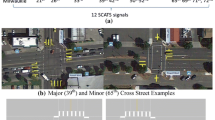Abstract
In this paper a new method to evaluate the network-wide effect of transit signal priority (TSP) is presented. A delay function is developed to estimate the effect of TSP at intersections using parameters such as traffic flow and signal characteristics. The proposed method is tested in two case studies. Firstly, it is applied to a single intersection to address both TSP strategy and model efficiency. Secondly, a set of TSP implementation scenarios is defined for a corridor in South-East Queensland, Australia. Bus and car delays are calculated for each scenario and the results are compared with those obtained using microsimulation. The results confirm that the delay estimated by the proposed method closely matches microsimulation results. The proposed method reflects the effects of having TSP at each intersection without performing time consuming microsimulation analyses. This method makes it possible to evaluate the effectiveness of TSP in large networks. The new method can be used to perform preliminary evaluation of TSP schemes at the network level, thereby potentially reducing the significant computational time of network analyses.








Similar content being viewed by others
References
Aashtiani H, Iravani H (1999) Use of intersection delay functions to improve reliability of traffic assignment model. In: 14th Annual International EMME/2 Conference, Chicago, Illinois. pp 1–6
Abdy ZR, Hellinga BR (2011) Analytical method for estimating the impact of transit signal priority on vehicle delay. J Transp Eng 137(8):589–600
Ahn K, Rakha H (2006) System-wide impacts of green extension transit signal priority. In: Intelligent Transportation Systems Conference, ITSC06. IEEE, pp 91–96. doi:10.1109/ITSC.2006.1706724
Akcelik R (1991) Travel time functions for transport planning purposes: Davidson’s function, its time dependent form and alternative travel time function. Australian Road Research 21(3)
Akçelik R (2011) SIDRA INTERSECTION 5.1. Akcelik and Associates Pty Ltd Vic 3104, AUSTRALIA
Baker RJ, Collura J, Dale J, Greenough J, Head L, Hemily B, Ivanovic M, Jarzab J, McCormick D, Obenberger J (2004) An overview of transit signal priority-revised and updated
Balke K, Dudek C, Urbanik Ii T (2000) Development and evaluation of intelligent bus priority concept. J Transp Res Board 1727 (1):12–19. doi:10.3141/1727-02
Chang J, Collura J, Dion F, Rakha H (2003) Evaluation of service reliability impacts of traffic signal priority strategies for bus transit. J Transp Res Board 1841(1):23–31. doi:10.3141/1841-03
Chen X, Yu L, Zhang Y, Guo J (2009) Analyzing urban bus service reliability at the stop, route, and network levels. Policy Pract 43(8):722–734. doi:http://dx.doi.org/10.1016/j.tra.2009.07.006
Currie G, K Goh K, Sarvi M (2013) An analytical approach to measuring the impacts of transit priority. Paper presented at the Transportation Research Boards: 92th Annual Conference, Washington, DC, January 2013
Danaher AR (2010) Bus and rail transit preferential treatments in mixed traffic, vol 83. Transportation Research Board, Washington
Danaher A, Levinson H, Zimmerman S (2007) Bus rapid transit: practitioner’s guide. Transit Cooperation Research Program, Report 118
Ekeila W, Sayed T, El Esawey M (2009) Development of dynamic transit signal priority strategy. J Transp Res Board 2111(1):1–9. doi:10.3141/2111-01
El-Geneidy A, Surprenant-Legault J (2010) Limited-stop bus service: an evaluation of an implementation strategy. Public Transp 2(4):291–306. doi:10.1007/s12469-010-0030-9
Ferreira L (2009) Redland BAY RD upgrade: microsimulation model (VISSIM) (Trans: Road TaM). vol 1. UniQuest, the University of Queensland, Australia
Garrow M, Machemehl RB (1997) Development and evaluation of transit signal priority strategies. University of Texas at Austin
Liu ZP, Li KP, Ni Y (2012) Isolated transit signal priority control strategy based on demand degree of green. In: London 2012 International Conference on System Simulation, ICUSS 2012
Liu H, Zhang J, Cheng D (2008) Analytical approach to evaluating transit signal priority. J Transp Sys Eng Info Technol 8(2):48–57. doi:http://dx.doi.org/10.1016/S1570-6672(08)60017-3
Mesbah M, Sarvi M, Currie G, Saffarzadeh M (2010) Policy-making tool for optimization of transit priority lanes in urban network. J Transp Res Board 2197(1):54–62. doi:10.3141/2197-07
Mesbah M, Sarvi M, Currie G (2011) Optimization of transit priority in the transportation network using a genetic algorithm. IEEE Trans Intell Transp Syst 12(3):908–919. doi:10.1109/TITS.2011.2144974
National Research Council. Transportation Research B (2010) HCM 2010: highway capacity manual. vol Book, Whole. Transportation Research Board, Washington, DC
Ngan V, Sayed T, Abdelfatah A (2004) Impacts of various traffic parameters on transit signal priority effectiveness. J Public Transp 7(3)
Rouphail NM, Huntsinger LF (2011) Bottleneck and queuing analysis. J Transp Res Board 2255:117–124. doi:10.3141/2255-13
Sayed T, Abdelfatah A (2004) Impacts of various parameters on transit signal priority effectiveness. J Public Transp 7(3)
Skabardonis A (2000) Control strategies for transit priority. J Transp Res Board 1727(1):20–26. doi:10.3141/1727-03
Skabardonis A, Christofa E (2011) Impact of transit signal priority on level of service at signalized intersections. Procedia Soc Beha Sci 16(0):612–619. doi:http://dx.doi.org/10.1016/j.sbspro.2011.04.481
Skabardonis A, Dowling R (1997) Improved speed-flow relationships for planning applications. J Transp Res Board 1572:18–23. doi:10.3141/1572-03
Smith HR, Hemily B, Ivanovic M (2005) Transit signal priority (TSP): a planning and implementation handbook. Federal Transit Administration (FTA), USA
Stevanovic J, Stevanovic A, Martin PT, Bauer T (2008) Stochastic optimization of traffic control and transit priority settings in VISSIM. Transp Res C: Emerg Technol 16(3):332–349. doi:10.1016/j.trc.2008.01.002
Stevanovic A, Stevanovic J, Kergaye C, Martin P (2011) Traffic control optimization for multi-modal operations in a large-scale urban network. In: Vienna 2011 IEEE Forum on Integrated and Sustainable Transportation Systems, FISTS 2011. pp 146–151
Sunkari SR, Beasley PS, Urbanik Ii T, Fambro DB (1995) Model to evaluate the impacts of bus priority on signalized intersections. Transportation Research Record 1494, Transportation Research Board, Washington DC, pp 117–123
VISSIM 5.4.1 Manual. PTV planning transport verkehr AG. Planung Transport Verkehr AG, Karlsruhe, Germany
Willumsen LG, Ortúzar JdD (2011) Modelling transport. vol Book, Whole. Wiley-Blackwell, Oxford
Zlatkovic M, Stevanovic A, Cevallos F, Johnson HR (2010) 35 M MAX: the first bus rapid transit system in Salt Lake County. World Rev Int Transp Res 3(1–2):103–120. doi:10.1504/WRITR.2010.031582
Author information
Authors and Affiliations
Corresponding author
Rights and permissions
About this article
Cite this article
Bagherian, M., Mesbah, M. & Ferreira, L. Using delay functions to evaluate transit priority at signals. Public Transp 7, 61–75 (2015). https://doi.org/10.1007/s12469-014-0090-3
Published:
Issue Date:
DOI: https://doi.org/10.1007/s12469-014-0090-3




